Mosaic was a subject of intense conversations at AirVenture Oshkosh 2023. In a surprise to many of us, FAA released the Notice of Proposed Rule Making (NPRM) for Mosaic ahead of schedule. Lots of people who needed to study it were already en route to the EAA show for a week, 10 days, or more.

If you already know enough, here are the links you need:
- Download USUA/LAMA MOSAIC NPRM Study Guide Version 1.0, PDF document with bookmarks and helpful organization
- Article on using the Study Guide
- Make a comment, direct link to FAA’s comment page
- Read what other commenters have said, FAA comment page
The Clock Is Ticking…
FAA offered 90 days to comment on their proposal that started out as 318 pages of text that no one would call fun reading. For a couple of weeks most people in the industry hardly had time to look at it. Now time is starting to grow short.
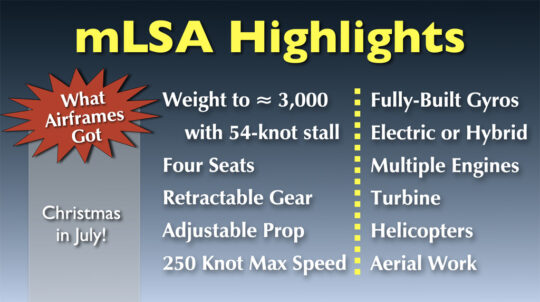
On the other hand, while portions of Mosaic are like Christmas in July, other sections stimulate questions, big and small. The document is only a proposal. It will change. Your comments could help move it in a direction you wish, but you have to comment to hope for an improvement.
The rule can be divided into two main parts: airplanes and pilot certificates plus operating limitations (including maintenance). The former is like “Christmas in July” with many capabilities industry and pilot member organizations sought. The latter describes who gets to fly (and maintain) these Mosaic LSA and under what rules. This section inspires more concern; some of this you can pick up from the nearby charts but learning more will take additional study and some discussion.
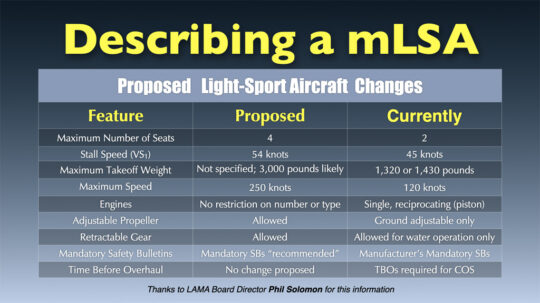
I have sought opinions and help digesting Mosaic. LAMA’s board of directors has been reviewing the proposal and board member Phil Solomon invested time in his area of focus. Thanks to Phil for info leading to these charts.
If possible, come to the Midwest LSA Expo 2023 where I will be presenting two talks on Mosaic, one on Friday at 11 AM and one at Saturday at 11 AM. Different people attend on different days, said airport manager Chris Collins, so he requested the presentation twice. I’m happy to do so as I am keen to hear what pilots think of Mosaic.
With this article you will see the most informative slides in that presentation. These represent the essence of what many pilots are seeking. I hope they will help your understanding.
Please Attend If Possible
To gain extra knowledge by hearing more detail, I encourage you to either come to the presentation or view the video on my YouTube channel; I will get it ready as quickly as possible. It should only take a few days — we don’t have so many left.
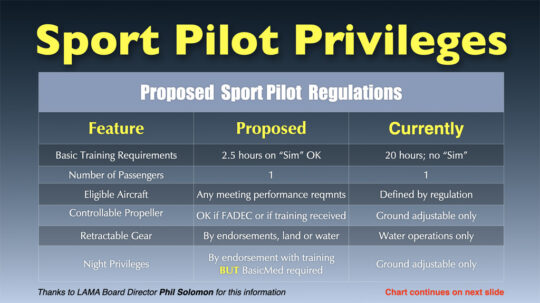
The charts were made to be shown large. If they look too small to read, enlarge using your computer or device methods; they should read well.
At my talks, me giving you my views of what’s contained in Mosaic has value, I trust, but the more important thing that should draw you to the show in person is to ask your own questions and hear those other people ask. Honestly, your opinion is what matters most.
The document is large and not particularly enjoyable reading. Nonetheless we have tried to make it somewhat easier digest with the USUA/LAMA Study Guide. I recommend you find elements of it that are meaningful to your enjoyment of flying and comment on them. Don’t try to assess the whole thing.
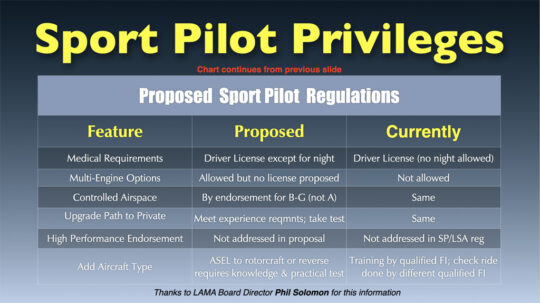
Now that I’ve given you some fascinating thoughts for the weekend I hope you’ll spend a little time because, folks, we’ve only got 50-some days left before the FAA goes back into their huddle to assess the comments and make changes. …tick, tock!
ARTICLE LINKS:
- Download USUA/LAMA MOSAIC NPRM Study Guide Version 1.0, PDF document with bookmarks and helpful organization
- Article on using the Study Guide
- Make a comment, direct link to FAA’s comment page
- Read what other commenters have said, FAA comment page
- Midwest LSA Expo 2023, free entry and parking


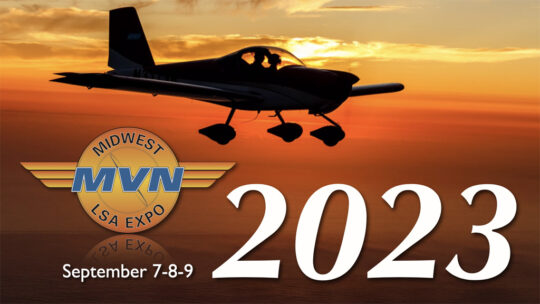
Many of us had to “retreat” to SLSA because BasicMed wasn’t an option. So having BM as a requirement for night operations seems counterproductive. If I could have gotten BM, I would still be in my Cardinal.
I believe that making additional privileges contingent on additional training and evaluation might be the way to go. For example, night flying would be contingent on appropriate flight training and evaluation in using a flight simulator. The same for IFR. So, with the appropriate training and evaluation a sport pilot could exercise privileges similar to a private pilot within the limitations of the aircraft (MTOW, seats, max cruise, stall, and etc.).
The additional cost for the biannual flight review (reevaluations of the additional privileges using a flight simulator and written test) would be partially offset by the driver’s license medical.
What you suggest in your first paragraph is essentially what FAA says in the Mosaic NPRM. Get some extra training, get endorsed, use your new privileges.
Your second paragraph implies the cost of a medical which is a necessary if you’re using sport pilot certificate privileges.
Dan, I’ve managed to only get to page 25. I took a cause for pause at this statement regarding the propulsion systems. “The proposal would require that the propulsion system be designed to preclude operation outside safe operating limits under normal operating conditions and that the system be consistently dependable for all intended operations. Accordingly, the propulsion system would be required to be designed with safety features to prevent the occurrence of operations such as the operation of propellers or rotors outside design RPM limits.” I am unaware of any certificated plane propulsion systems that accomplish this feat….much less a requirement for the new rules. I’m real curious how one actually accomplishes this absent a computer controlled propeller that is tied to the engine ECU. Perhaps I misinterpreting “safe operating limits” or “normal operating conditions”…controlled flight?. If the rest of the expansion of the operating realm is based on delivering on this criteria…it would seem difficult to accomplish in the near term.
I think the intent of the proposal is for manufacturing to focus of FADEC controlled propellers and mixture. Single lever. This is already being done in alot of aircraft
Maurice, I agree with you observation on what may be the intent. As written that the intent is a requirement. A hydraulic pilot controlled propeller does not match that criteria, nor does a fixed pitch or ground adjustable propeller that can be exceed RPM in a reasonable descent absent an automatic power reduction commanded by a FADEC. I get aggravated enough when a car manufacturer knows when you should brake and it actually causes an accident. The follow-on would be that if the manufacturers can only provide a FADEC controlled propeller that is linked with the computer of the ECU for the engine….we now have a very expensive engine/propeller combination. The FAA has a habit of evolving an “intent” to a “requirement”. Recall what happened with LODA. The lawyers were able to eradicate safety (part of the FAA mission)for experimental aircraft. It took months to rectify. A look at the maintenance portion of the NPRM is a great example of taking progress and reverting to old ways of accomplishing things that end up limiting safe operation, not enhancing. Intent should be described as such. The word of concern is require. Someone wanting to take an existing aircraft with a fixed pitch propeller and carbs and have it included as light sport….would not meet that proposed criteria.
I wish I could be at the gathering in two weeks, but I was travelling for over a week, and have things I need to do at home for the next couple weekends. I look forward to seeing your video of the presentation in Mount Vernon as soon as you can get it up. Thanks for all the hard work that you do for us.
Thanks Dan!
A great summary that should help folks get on board with submitting comments.
I have Midwest LSA Expo on my calendar, but will miss it this year for a conflict with a paragliding competition. Sorry to miss your talk(s).
Many thanks for your continued efforts in support of flying in all its forms. You are a tremendous asset to pilots everywhere, and I hope more of them acknowledge it.
Best of lift!
Thanks, Eric. I’m glad you found the information helpful.
Some of the improvements are great. This will make flying more accessible to people.
My question is the FAA needs to get with the times on medical. Pacemakers and defibrillators are becoming more common. How about letting people like them be able to flight again. Is there something that can be done?
That is not a part of the proposal
Some industry stakeholders have asked the FAA for a 90-day extension to the comment period in an attempt to stall the implementation of Mosaic. It is very possible that they will get it and Mosaic may not become law until 2025 if at all.
You are correct that a group of organizations involved with the maintenance industry have requested a 90-day extension to the comment period. This is not unusual in FAA’s rule making.
I don’t know what their intention is with this, but others agree with you that this could delay the rule, and could have larger effects.